
For photojournalist, Samantha Reinders, Kathmandu is as striking as the first time she visited 15 years ago.
She reveals the allure of Nepal’s capital and tells us about the magic that keeps taking her back.
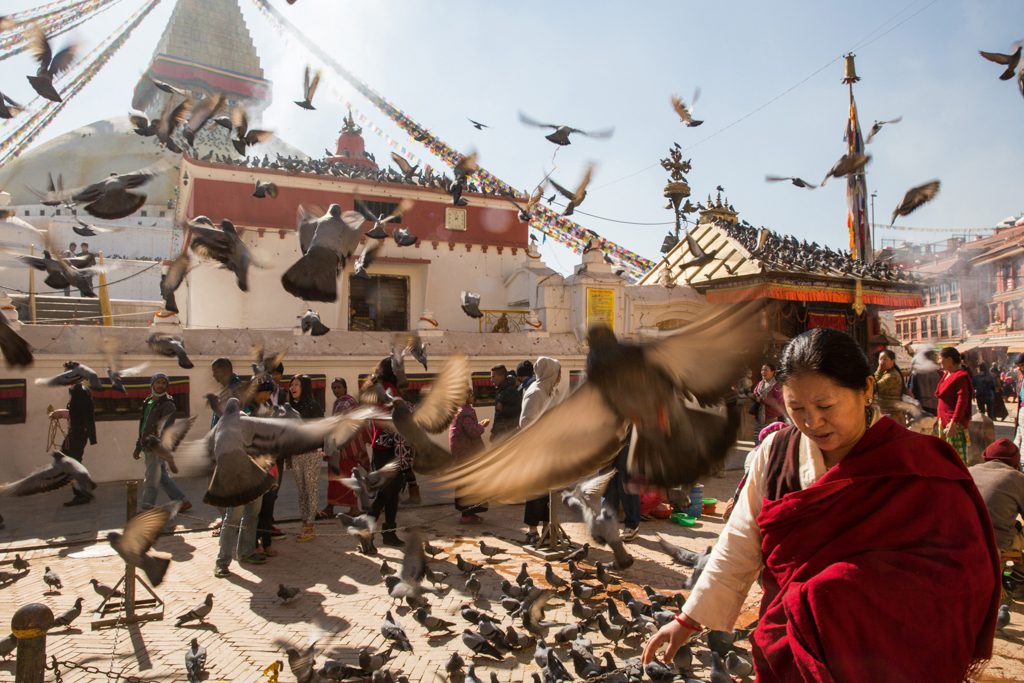
Over and above the busy scenes Boudhanath are thousands of pigeons. Buddhist practitioners feed them seeds every morning as offerings to acquire good karma. Photo by Sam Reinders.
Namaste from Nepal. It’s New Year’s Day. And the year is 2073 (according to Nepal’s lunar calendar). I just realised it’s my 15-year anniversary of coming to this teeny-tiny kingdom. (Remember that time I visited in 2001 for two weeks and stayed a year? I guess this place still hasn’t lost its grip on me…)
Kathmandu is an imperfect Shangri-La. There’s prettiness, yes. But also nasty pollution and poverty and traffic like you’ve never seen. Yet there is something about the absurd interface of East and West that draws me in. That, and the fact that it’s easy on my wallet! Most tourists come here just to trek. For me the beauty is in the pulse of the city.
Over the years I’ve learnt it’s advisable to ease yourself into Kathmandu. And this time I spent my first day finding a tea shop and just sitting and watching. Thamel, the area where I’m staying, is a tourist hotspot – a UN without the suits. It’s convenient but it’s not the real Kathmandu. So I walked south, away from the shops selling knock-off North Face fleeces and sidestepping Tiger Balm salesmen.
From my spot, the sweet tea rushing through my veins and my jet lag giving way to that familiar feeling of excitement, I watched the world go by: people walk past the ubiquitous small Hindu shrines, put their hand to head and scoop up a blessing; an old lady has her toenails cut by a vendor, an entire family (dog included) putters past on a motorbike, a man carries a load three times his size on his doubled-over back and a skinny-legged-yoga-mat-toting tourist looks lost.
There’s hooting, spitting, haggling and the sizzling of ghee as a lady drops a load of sel rotis (doughnuts) into a cauldron the size of a Smart car. A teenager pops a wheelie and a monk wearing Converse kicks saunters past. I’m back!
That afternoon I headed up to Swayambhunath. It’s a Buddhist stupa (massive white dome topped by a gold block with the Buddha’s huge haunting eyes painted on it) that sits on a hill to the west of the city. It’s one of Kathmandu’s most recognisable symbols. Ancient lore tells a story of the bodhisattva who originally raised the hill. His long locks were infested with lice. Said lice transformed, so the story goes, into the hundreds of monkeys that roam the temple complex.

Swayambhunath is one of Nepal’s oldest religious sites. Photo by Sam Reinders.
I’m all for old tales but I suspect the cheeky buggers just hang around to eat the rice and fruit that devotees leave as offerings. There are 365 steps to get up to the temple, each one rounded from centuries of pilgrims’ feet making their way to the top to send prayers to the gods. Monkeys hang from the prayer flags that guide you upwards (and help take your mind off your aching thighs). At the top a low hum of prayer – ‘Om Mani Padme Hum’ – is broken by the flapping of those flags and the sound of metal prayer wheels spinning on their axes, sending their hopes skywards.
The view is amazing. It feels like you’re floating above the chaos and fumes. In my 15 years of coming here, it was the cleanest I’d seen the air. Set against a brilliant blue sky I got a 360-degree view of the snow-covered Himalayan peaks. I could pick out Lantang and Everest…
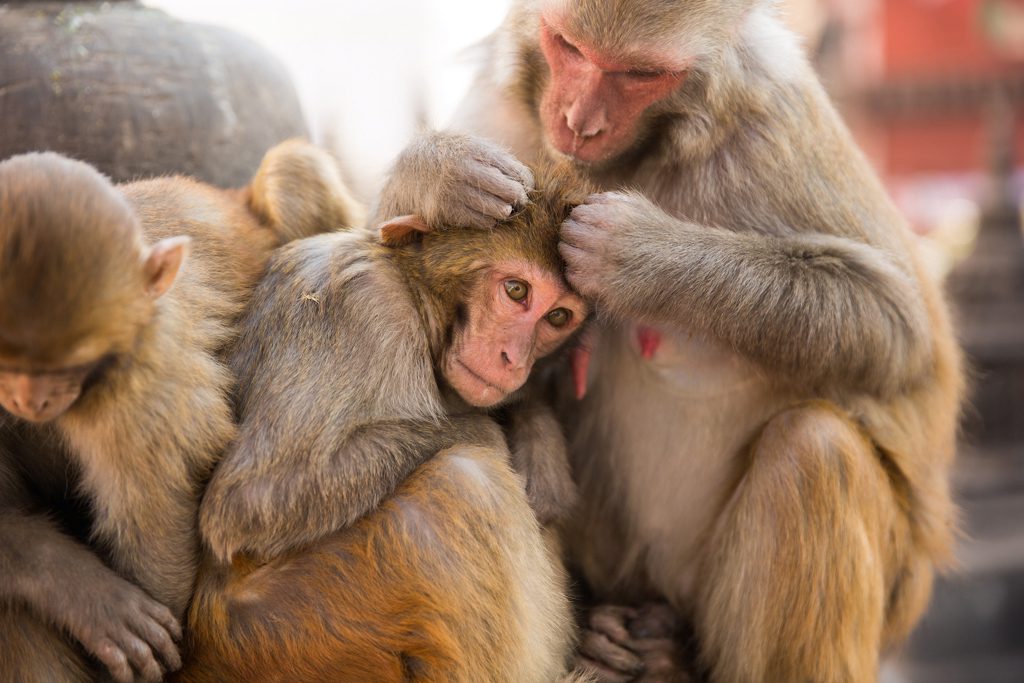
Monkeys hang out and groom each other at Swayambhunath, which is called Monkey Temple (for good reason). Photo by Sam Reinders.
I took my shoes off to enter a monastery where a ceremony was in full swing. It was dark, with beams of light sneaking through cracks in the window shutters. Monks, aged from five to those who looked 95, knelt in red robes, their faces lit by the light of hundreds of butter lamps. Ancient scriptures on rectangular parchment lay in front of them. They chanted to a backdrop of groaning long horns, clanging cymbals and the shrill of trumpets made from conch shells. It smelt of yak butter and incense.
Back in Thamel, falling asleep had its own unique soundtrack: 80s cover songs, barking dogs and roosters with insomnia.
On Wednesday I took a taxi out to Boudhanath. It’s like Swayambhunath on steroids and one of the most important Tibetan Buddhist monuments outside of Tibet. The area around it has been a magnet for Tibetan exiles since the late 1950s. Getting out of the taxi, you feel like you’re in a different country altogether. The Tibetan flag whips in the wind, most people are in full Tibetan dress and you’ll struggle to hear Nepalese. For the best momos in Kathmandu (dumplings filled with veggies or water buffalo meat – equally delicious and addictive), this is the place.
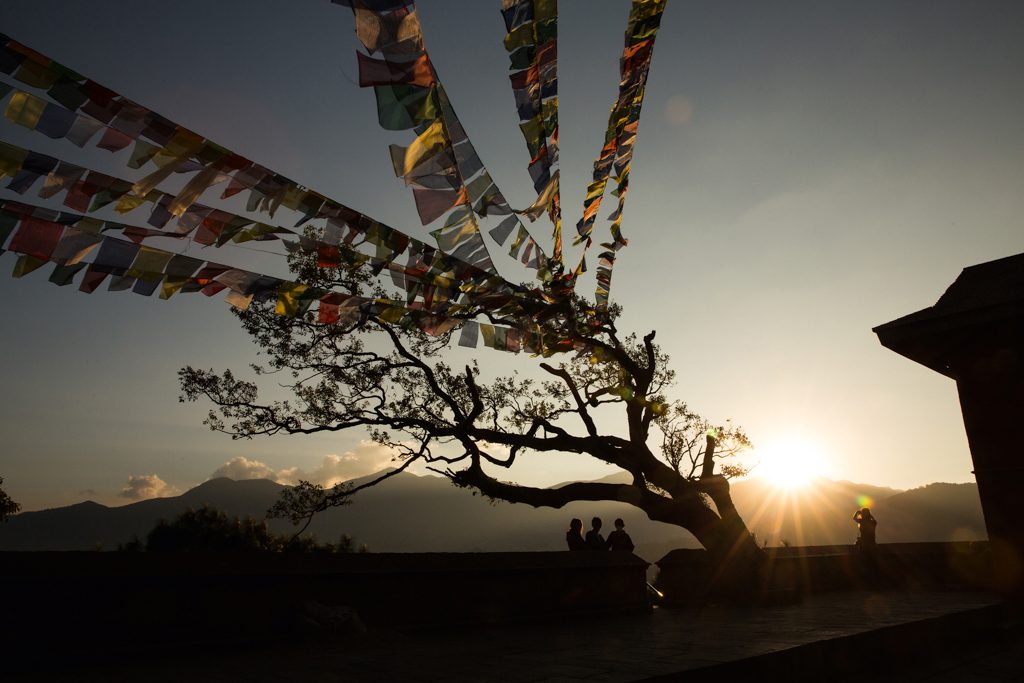
Sunset from Swayumbunath stupa is one of the finest in the city. Photo by Sam Reinders.
Boudhanath was severely damaged in the 2015 earthquake and today was the official opening of the newly whitewashed, freshly flagged stupa. The usually crowded place had swollen into a moving torrent. I was practically lifted from the taxi and hardly felt my feet touch the ground as I moved around the stupa with the snake of people.
Lamas from around the world sat on the dome and the important ones (those with bodyguards – they are the Beyonces of Buddhism) delivered blessings. I retreated to the Café du Temple, one of the rooftop restaurants that surround the stupa, and took it all in from above the melee. A Buddha Air flight left a jet trail in the crisp November air and hundreds of kites danced from the city’s rooftops.
Monks outnumber ordinary citizens in this part of town. Tall ones, short ones, fat ones, thin ones, old ones, young ones and, well, ones of varying degrees of austerity. Some prostrate (throw themselves to the ground in worship) – a sight, which if you are not expecting it, can be a little alarming! Others take selfies. Meditating, giggling, chanting and cappuccino drinking happen in equal measure.
On my way back I explored the maze of monasteries around the main stupa. In a flurry of excitement and universal hand gesturing, a cricket ball was thrown my way and I was asked to join a group of pint-sized monks on a makeshift pitch. I’d be lying if I said I didn’t let South Africa down a little. I was knocked out of the park. Or, in this case, the monastery walls.
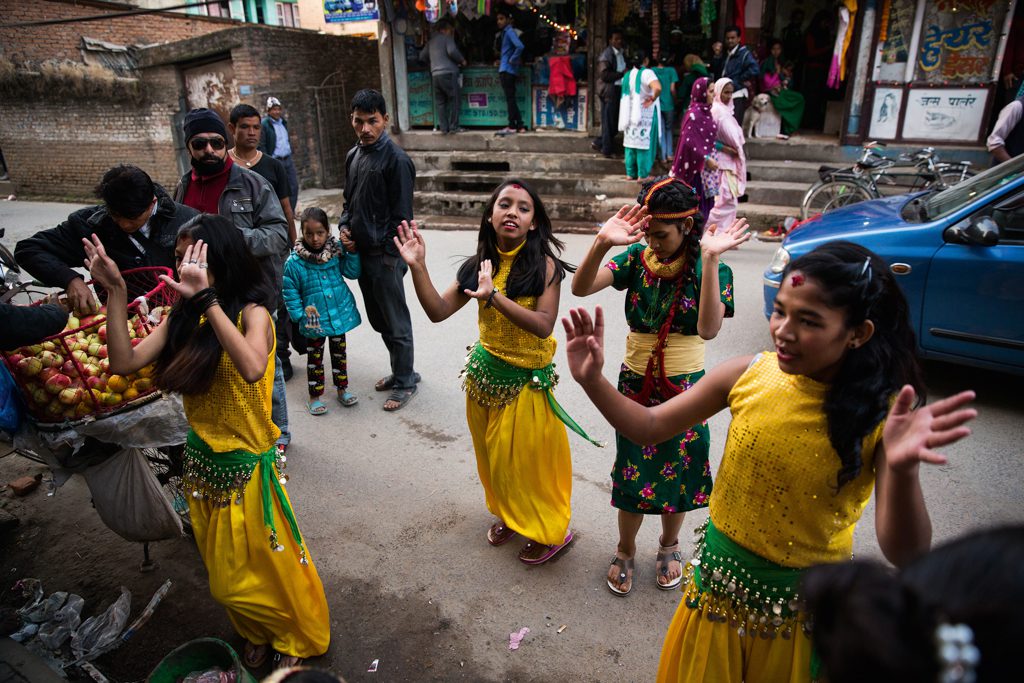
During Laxmi Puja, fireworks pop, bars turn up the music and kids in traditional dress sing and dance to give blessings to shop owners. Photo by Sam Reinders.
By Thursday I was a little templed out and decided to rather walk. One of my favourite things about Kathmandu is that even after 15 years I am still able to get horribly lost. The sensory overload can override even the best navigational skills as you wander the labyrinth of alleyways and side streets.
Life beats to a different drum here. Individual daily rhythm is set to an unhurried pace, all but obsolete in today’s world. But collectively it’s a retina overload. The city is dripping in temples, tradition, superstition and mystery, colour and pandemonium – at least to the foreign eye.
I took a break at Asan Tol – the intersection of ancient trade routes. There are beggars in bandages, piles of pomegranates, sleeping rickshaw drivers, pigtailed school kids, lone cows (I saw one sneak up on a girl, causing her to squeal), heaps of marigolds, a tent where people can get tested for diabetes, yak tails for sale, flickering candles, hooting taxis, traffic officials trying (and failing) to bring calm to chaos, posters of Hendrix, Messi and Marley and steaming pots of momos on the go. It’s beautiful, beautiful chaos.
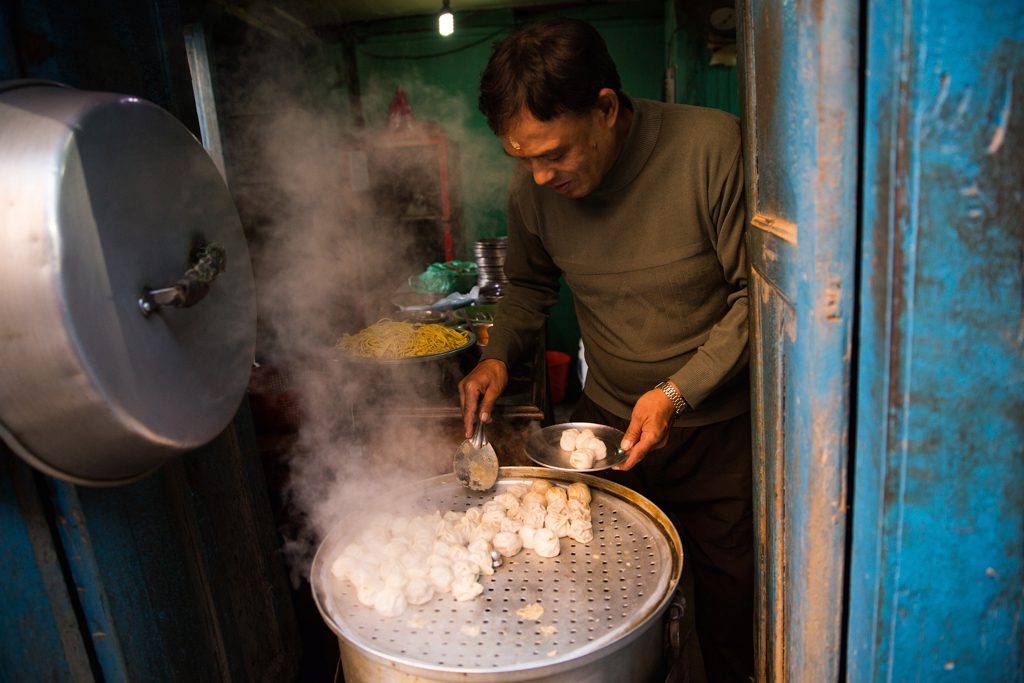
Just look out for plumes of steam emanating from the entrance of small shops for freshly steamed momo. Photo by Sam Reinders.
This past weekend was the culmination of Tihar: a five-day celebration that sees in the Newari (the people of the Kathmandu Valley) New Year. It starts with a day dedicated to worshipping the crow. While we wouldn’t give these guys a second look, in the Hindu pantheon they decide who goes on to a fortunate rebirth, and who doesn’t. The day after belongs to the dog – they ease a soul’s passage into the afterlife. It doesn’t matter how matted or mangy, dogs wander the streets with garlands of marigolds around their necks and splashes of bright red tika powder on their foreheads.
Then it’s the cow. They’re revered all year round (kill one of them and you’ll get life in prison) but on the third day of this festival they get even more attention. The evening belongs to Laxmi Puja. On this night the goddess of wealth is said to circle the globe at midnight and visit and bless the households and businesses that have prepared for her visit. And prepare they do!
Homes are scrubbed; lamps, candles and garlands of flowers are placed at windows and above doors. Outside, intricate mandalas are drawn using coloured powders, flower petals, fruits, oils and candles. From there a pathway is made leading to where the valuables are kept, thereby sanctifying every spot where Laxmi will tread. She’ll bring wealth for the coming year, hopefully…
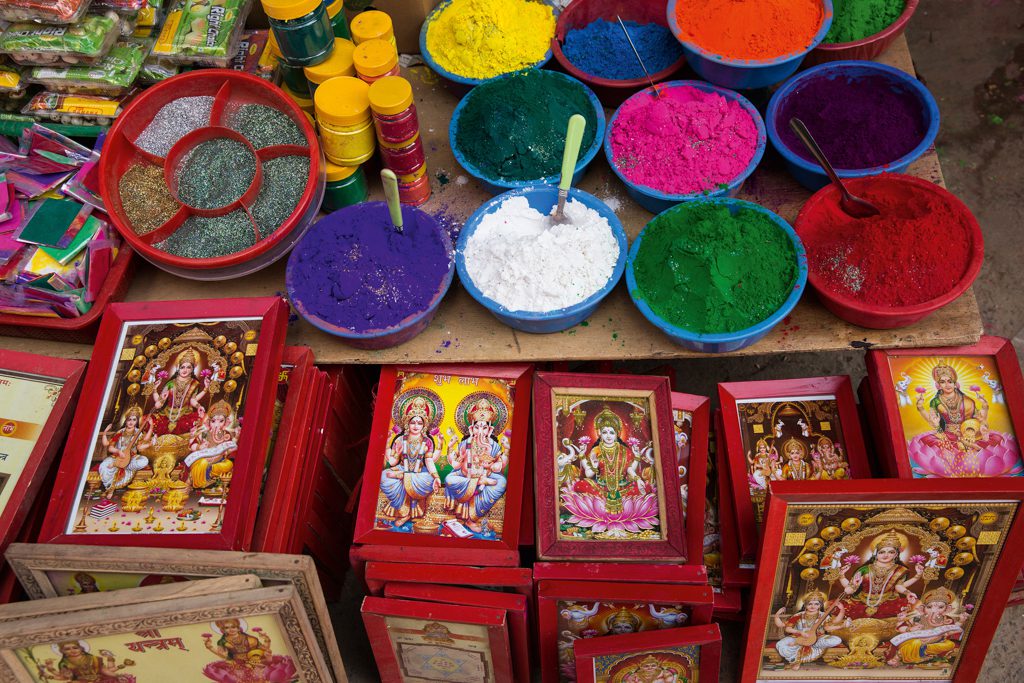
Mounds of iridescent tika powders for sale. They are mixed with oil and used to mark animals or people as commemoration. Photo by Sam Reinders.
It’s a sight to behold and makes you feel like an actor in a movie on fast forward. Groups of kids roam from door to door singing traditional songs, receiving money or sweets for their efforts. Fireworks explode, followed by shrieks of laughter and giggling the sound of pure childhood bliss. Processions of people dance through the maze of streets, banging on drums, playing flutes and singing at the tops of their voices.
Though I’d experienced it all before, it still made me feel like a child celebrating Christmas, Guy Fawkes, Halloween and Thanksgiving all in one giddy moment. Overwhelmed, I dipped into Tom and Jerry’s, my favourite bar in Thamel. It was empty except for my friends behind the counter and a lone German tourist. I ordered a hot rum punch (in itself, worth a visit to Kathmandu) and a few kids came in.
I presumed they’d sing one of their songs and be on their way. Instead they handed the barman a CD. And then Swedish pop sensations the Vengaboys blasted from the speakers. The children jiggled and jived and motioned to the German to join in the dance. He pointed at me and said he would if I would. There was no way out… And so it was that on a chilly New Year’s Eve in Kathmandu I found myself dancing with a group of 10 year olds, a German tourist and a gap- toothed waiter, to the Vengaboys!
Today, a Sunday, the festivities take place at home and most businesses are closed. An eerie silence engulfs the city and it feels like Kathmandu is hung over. I’ve retreated to the Garden of Dreams – a small public park in the middle of city. It’s usually filled with teenagers taking selfies or holding hands away from the prying eyes of their parents. Today it’s just tourists like me, lazing on the grass, writing in their journals or typing on their phones. Just like I am right now…
There’s still Patan and Bhaktapur, the Kathmandu Valley’s other ancient cities, to explore, so I need to hit send and plan my next couple of days. Chat soon, Sam.
Plan your trip to Nepal
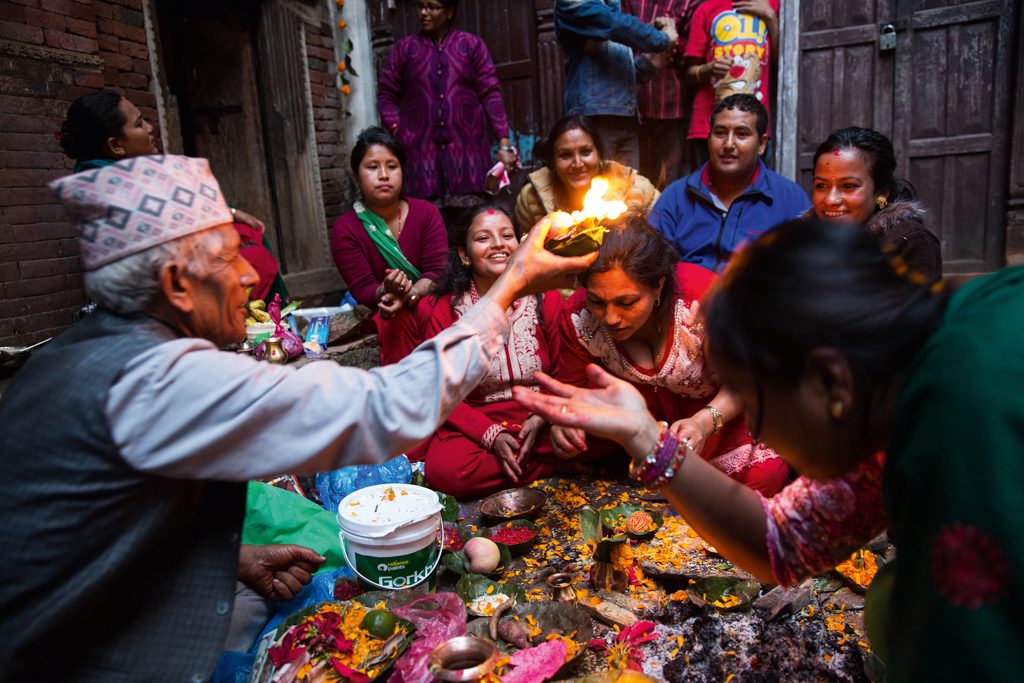
The head of the household conducts a ceremony in his home to welcome Laxmi (and the opulence she brings) for the coming year. Photo by Sam Reinders.
Getting there
Flights from Joburg or Cape Town are via Dubai, Doha, Hong Kong or Mumbai, depending on airline. From R12500 return with qatarairways.com. Arrange an airport pick-up with your guest house. From R73 per person.
When to go
October and November are high season. The weather is good (for getting views of the Himalayas), it’s the most popular time to trek and things are a little more expensive. Tihar is a festive time to be in Nepal – the dates depend on the lunar calendar and change annually (do a Google search).
Need to know
South Africans can get a visa on arrival (R425 for 15 days). There is fairly good (and free) Wi-Fi in most places but get a local SIM card (Ncell, R18) anyway. There’s an ATM on every corner. You can buy anything here you’ve forgotten at home, so pack light.
Cost
I spent R20000 on my last 10-day trip (flights included). To keep costs down book your flight well in advance, eat local food (with the odd splurge) and stay in affordable guest houses. Where possible, walk instead of taking taxis. Alcohol (especially wine and even beer) is very expensive so rather buy something at duty free on the way.
Stay here
The Thamel district of Kathmandu is overrun with accommodation, and places often look quite different from the website. Noise can be a problem. Pick a hotel off the main roads and book online in advance – it’s usually cheaper.
Shree Tibet Family Guest House has simple yet spotless rooms. There’s also a small communal rooftop terrace – great for morning coffee. Rooms from R190 for two.
Serenity Hotel, in the same street, is a step up. It’s modern, airy and away from the bustle. Rooms from R450 for two.
Do this
Buy yak socks. They’re about R60 a pair and you won’t regret it. They’re everywhere.
Visit Swayambhunath and Boudhanath. Both temples have a main structure (stupa) but exploring the smaller temples and monasteries around them is the most fun. There’s no map, just wander! Entrance is R18 per person for the day (keep your ticket handy as there is the odd spot check.
Go trekking. There are hundreds of routes in Nepal, and Kathmandu is the perfect place to acclimatise culturally before, and relax after, your trek. If you’re travelling solo keep an eye on the notice boards in Thamel for people looking for trekking partners. You’ll need a trekking permit (called a TIMS) and a permit for the area you’ll be trekking in. Both are easily available and affordable. Costs vary depending on the type of trek. I recommend speaking to Babu Sitaula at Unique Path Trekking. nepaltrekkinginfo.com
Eat here
In Thamel you’ll find any Western meal you’d find on a menu in SA, for roughly the same price. Try the local delicacies though – they’ll help your budget and are delicious (the real spots are off the main roads). Momos (steamed or fried dumplings with fillings), thukpa (Tibetan noodle soup) and dal bhat (rice and dal) are all good. Momos from R15, dal bhat from R30. Western Tandoori is a must for good Indian food. It’s on Amrit Marg road, but street names aren’t used much. Rather ask a local to direct you. Meals (that will fill you up) cost from R50.
Also read: a luxury train ride across India: Deccan decadence
This story first appeared in the May 2017 issue of Getaway magazine.
From our ultimate guide to Addo, free things to do in your city, a photographic getaway to South Luangwa and getting the best of Nepal; our May issue is guaranteed to inspire.
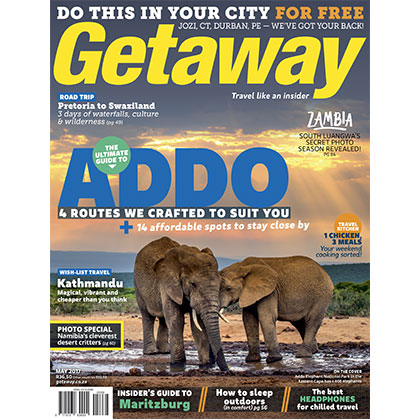
This article, Why Kathmandu will capture your heart, was originally posted on the Getaway Blog by Getaway.